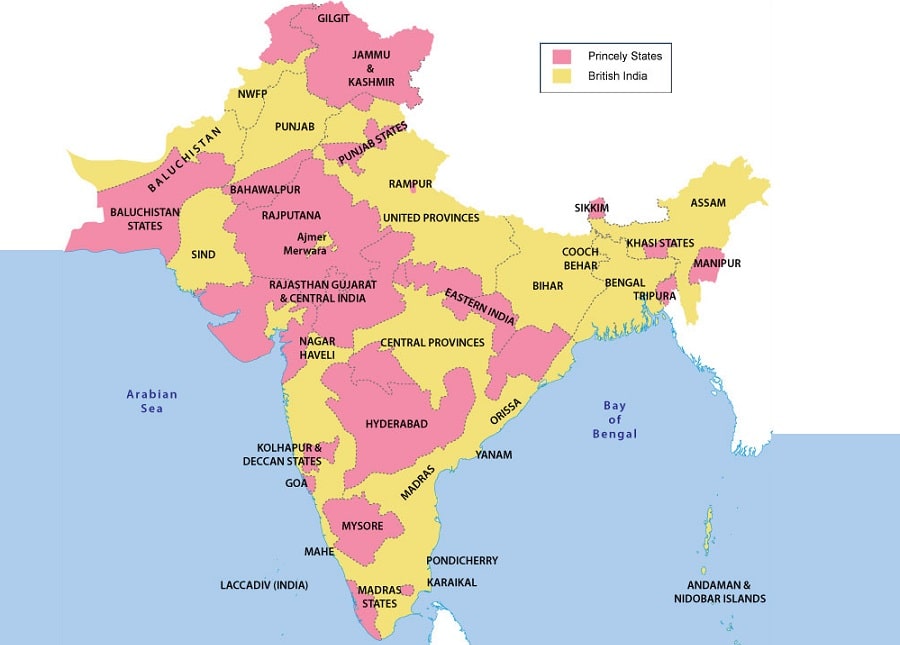March 13, 2019
Expansion of British Rule in India
Contents
subsidiary alliance doctrine of lapse
- The ‘first empire’ stretching across the Atlantic towards America and the West Indies.
- The ‘second empire’ beginning around 1783 (Peace of Paris) and swinging towards the East-Asia and Africa.
- Imperial history of Britain started with the conquest of Ireland in the sixteenth century.
- Initially Company officials started acquiring territory just to promote and protect their trade interests.
- They came to realize how easily they could pit one local ruler against another and began to interfere in local politics and, in the process, acquired territories.
- Later on the British politicians back in Britain and the administrators in India worked on a clear desire to establish an empire.
- Process of imperial expansion and consolidation of British paramountcy was carried on by Company during the 1757-1857.
- There was 2-fold method
- Policy of annexation by conquest or war
- Policy of annexation by diplomacy and administrative mechanisms
>>>>>>>

>>>>>>>
Mysore’s Resistance to the Company
1st Anglo-Mysore War (1767-69)
- 1st Anglo-Mysore War started in 1767.
- Nizam, the Marathas, and the English allied together against Haidar Ali.
- But Haidar Ali trun Nizam and Maratha neutral by his diplomatic skill
- He suddenly attacked Madras.
- English has to conclude a very humiliating Treaty of Madras, 1769.
- 1st Anglo-Mysore War came to end with this treaty.
2nd Anglo-Mysore War (1780-84)
- Haidar Ali accused the English of breach of faith of the Treaty of Madras when in 1771 Marathas attacked him.
- French were much more helpful than the English in meeting his army’s requirement of guns, saltpetre and lead.
- Haidar Ali considered the English attempt to capture Mahe a direct challenge to his authority.
- Haidar Ali forged an anti-English alliance with the Marathas and the Nizam in Anglo-Mysore War.
- He suffer a defeat at Porto Novo in November 1781.
- Haidar Ali died of cancer on 1782.
- His son, Tipu Sultan, carried on war without any positive outcome
- Fed up with an inconclusive war, both sides opted for peace, negotiating the Treaty of Mangalore (March, 1784).
- 2nd Anglo-Mysore War came into end.
>>>>>>

>>>>>>
3rd Anglo-Mysore War (1790-92)
- 1790, Tipu declared war against Travancore for the restoration of his rights, and 3rd Anglo-Mysore War was started.
- 1790, Tipu defeated the English under General Meadows.
- 1791, Cornwallis took the leadership and at the head of a large army marched through Ambur and Vellore to Bangalore and from there to Seringapatam.
- With the help of Nizam and Maratha English won against Tipu on the second attempt.
- Treaty of Seringapatam 1792 was signed between Tipu Sultan, East India Company, Nizam of Hyderabad, and Maratha Empire.
- Tipu Sultan has to surrender half of his territory.
- Tipu’s two sons were taken as hostages by the Company.
4th Anglo-Mysore War (1799)
- In 1798, Lord Wellesley became the new Governor General.
- 4th Anglo-Mysore War began on April 17, 1799, and ended on May 4, 1799 with the fall of Seringapatam.
- Tipu was defeated first by General Stuart and then by General Harris.
- Arthur Wellesley, the brother of Lord Wellesley, also participated in the war.
- In 4th Anglo-Mysore War, English were again helped by the Marathas and the Nizam.
- Tipu laid down his life fighting bravely.
- English chose a boy from the earlier Hindu royal family of Mysore (Wodeyars) as the maharaja and imposed on him the subsidiary alliance system.
- 1831 William Bentinck took control of Mysore on grounds of mis-governance.
- 1881 Lord Ripon restored the kingdom to its ruler.
>>>>>>

>>>>>>
Anglo-Maratha Struggle
- Defeat at Panipat and later the death of the young Peshwa, Madhavrao I, in 1772, weakened power of Peshwas.
- English in Bombay wanted to establish a government like Bengal, Bihar and Orissa.
- Divided house of the Marathas that encouraged the English to hope for success in their venture.
1st Anglo-Maratha War (1775-82)
- After the death of Madhavrao in 1772, his brother Narayanrao succeeded him as the fifth peshwa.
- His uncle, Raghunathrao, killed him and named himself as the next peshwa.
- Narayanrao’s widow, Gangabai, gave birth to a son named ‘Sawai’ Madhavrao.
- 12 Maratha chiefs (Barabhai), led by Nana Phadnavis, made the infant as the new peshwa.
- Raghunathrao sought help from the English at Bombay and signed the Treaty of Surat in 1775.
- Under the treaty, Raghunathrao ceded the territories of Salsette and Bassein to the English etc.
- In return, the English were to provide Raghunathrao with 2,500 soldiers.
- Battle at Talegaon 1776 was fought in which Marathas led by Nana Phadnavis defeated British.
- British Calcutta Council, condemned the Treaty of Surat and sent Colonel Upton to Pune for new treaty.
- Treaty of Purandhar, 1776 signed with Raghunath Rao and promising him a pension.
- 1777, Nana Phadnavis violated his treaty with the Calcutta Council by granting French a port on the west coast.
- English and the Maratha armies met on the outskirts of Pune.
- English defeated and surrendered in Jan 1779 and signed the Treaty of Wadgaon.
- Warren Hastings rejected the Treaty of Wadgaon and sent a large force of soldiers.
- 1781 the English, under General Camac, finally defeated Sindhia at Sipri.
- Sindhia proposed a new treaty between the Peshwa and the English
- Treaty of Salbai, 1782 signed after a 2 years of deadlock and war.
- It was ratified by Hastings and Phadnavis.
- The treaty guaranteed peace between two sides for 20 years.
- English returned all the Maratha territories except Salsette.
- English should not offer any further support to Raghunathrao and Peshwa should grant him a maintenance allowance.
- Peshwa should not support any other European nation.
2nd Anglo Maratha War (1803-1805)
- After Death of Madhavrao in 1795, Bajirao II son of Raghunathrao, became the Peshwa.
- Death of Nana Phadnavis in 1800 gave the British an added advantage.
- After his death, Bhonsle defeated Sindhia and Bajirao II.
- Baji Rao II fled to Bassein 1802 and signed Subsidiary Alliance treaty with English Treaty of Bassein 1802.
- Sindhia and Bhonsle attempted to save Maratha independence.
- English under Arthur Wellesley defeated the combined armies of Sindhia and Bhonsle.
- They forced to conclude separate subsidiary treaties with the English.
- In 1804, Yashwantrao Holkar made an attempt to fight against the English and were defeated
- Bhonsle – Treaty of Devgaon, 1803
- Sindhia – Treaty of Surajianjangaon, 1803
- Holkar – Treaty of Rajpurghat, 1806
Pindari War (1817-18)
- Pindaris, made up of many castes and classes, were attached to Maratha armies as mercenaries.
- When the Marathas became weak, the Pindaris could not get regular employment.
- They started plundering neighbouring territories, including those of the Company.
- English troops surrounded them in Malwa region and Gwalior to force surrender.
- Pindari leaders like Amir Khan and Karim Khan surrendered while Chitu Khan fled into the jungles.
- They was given jobs as police and offered pensions along with land.
>>>>>>>

>>>>>>>
3rd Anglo-Maratha War (1817-19)
- Bajirao II made a last bid in 1817 by rallying together the Maratha chiefs against the English.
- Peshwa attacked the British Residency at Poona.
- Appa Sahib of Nagpur attacked the residency at Nagpur.
- Peshwa was defeated at Khirki, Bhonsle at Sitabuldi, and Holkar at Mahidpur
- Peshwa – Treaty of Poona 1817
- Sindhia – Treaty of Gwalior 1817
- Holkar – Treaty of Mandasor 1818
- Peshwa surrendered and Maratha confederacy and peshwaship was dissolved.
- Bajirao II became a British retainer at Bithur near Kanpur.
- Pratap Singh, a lineal descendant of Shivaji, was made ruler of a small principality, Satara.
Cause of Marathas Lost
- Poor Leadership
- Defective Nature of Maratha State
- There was no effort, right from the days of Shivaji, for a well thought out organised communal improvement, spread of education or unification of the people.
- The rise of the Maratha state was based on the religio-national movement.
- Loose Political Setup
- Lack of a cooperative spirit among the Maratha chiefs.
- Inferior Military System
- Marathas were inferior to the English in organisation of the forces, in war weapons, in disciplined action.
- Unstable Economic Policy
- Maratha leadership failed to evolve a stable economic policy. There were no industries or foreign trade openings.
- Superior English Diplomacy and Espionage
- The English attacked a ‘divided house’ which started crumbling after a few pushes.
>>>>>>>

>>>>>>>
Conquest of Sindh
Rise of Talpuras Amirs
- Prior to the rule of Talpuras Amirs, Sindh was ruled by the Kallora chiefs.
- In 1758, an English factory was built at Thatta, given by the Kallora prince, Ghulam Shah.
- He excluded other Europeans from trading there.
- In the 1770s, a Baluch tribe called Talpuras, descended from the hills and settled in the plains of Sindh.
- In 1783, Talpuras, under the leadership of Mir Fath (Fatah) Ali Khan, established complete hold over Sindh.
- They conquered Amarkot from the Raja of Jodhpur, Karachi from the chief of Luz, Shaikarpur and Bukkar from the Afghans.
Gradual Ascendancy over Sindh
- Under the influence of Tipu Sultan and local traders Amir in 1800, ordered the British agent to quit Sindh.
- In 1807, alliance of Tilsit with Alexander I of Russia was joined by Napoleon Bonaparte.
- Alliance had a condition of combined invasion of India by the land route.
- British wanted to create a barrier between Russia and British India.
- Lord Minto sent Metcalfe to Lahore, Elphinstone to Kabul and Malcolm to Teheran.
- Sindh was visited by Nicholas Smith who met the Amirs.
- Treaty of eternal friendship was signed.
- Both side agreed to exclude the French from Sindh.
- Treaty was renewed in 1820 with the addition of an article excluding Americans.
- Treaty of 1832 singed between William Bentinck and Amirs.
- Free passage through Sindh would be allowed to the English traders and travellers and the use of Indus for trading purposes.
- No warships would ply, nor any materials for war would be carried.
- No English merchant would settle down in Sindh, and passports would be needed for travellers.
- Company persuaded Ranjit Singh to sign Tripartite Treaty of 1838.
- As per treaty British will mediation in his disputes with the Amirs.
- Sindh Accepts Subsidiary Alliance in 1839.
- 1st Anglo-Afghan War (1839-42), fought on the soil of Sindh.
- Amirs were charged with treasonable activities against the British.
- Lord Ellenborough provoked Amirs and people of Sindh into a war.
- Amirs were made captives and banished from Sindh in 1843.
- Sindh was merged into British Empire.
- Charles Napier was its 1st governor.
>>>>>>

>>>>>>>
Anglo-Sikh War
Punjab After Ranjit Singh
- In 1843, Daleep Singh, a minor son of Ranjit Singh,was proclaimed Maharaja with Rani Jindan as regent and Hira Singh Dogra as wazir.
- In 1845 Lal Singh won over army to his side and became the wazir.
- Teja Singh was appointed as the commander of the forces.
1st Anglo-Sikh War (1845-46)
- Death of Maharaja Ranjit Singh resulting in a power struggle for domination between court at Lahore and the ever powerful and increasingly local army.
- Suspicions amongst Sikh army arising from English military campaigns to annex of Gwalior and Sindh in 1841 and the campaign in Afghanistan in 1842.
- Increase in the number of English troops being stationed near the border with Lahore kingdom.
- War began in Dec 1845 with 20,000 to 30,000 troops in the British side, while Sikhs had about 50,000 men.
- Treachery of Lal Singh and Teja Singh caused 5 successive defeats to the Sikhs.
- Lahore captured by British forces on Feb 1846 without a fight.
- Sikhs forced to sign a humiliating Treaty of Lahore, 1846.
- Jalandhar Doab (between Beas and Sutlej) was annexed to the Company’s dominions.
- Strength of the Sikh army was reduced.
- Daleep Singh was recognised as the ruler under Rani Jindan as regent and Lal Singh as Wazir.
- Since, the Sikhs were not able to pay the entire war indemnity, Kashmir including Jammu was sold to Gulab Singh.
- Transfer of Kashmir to Gulab Singh was formalised by a separate treaty.
- Sikhs were not satisfied with the Treaty of Lahore over the issue of Kashmir, so they rebelled.
- Dec 1846, Treaty of Bhairowal was signed.
- According to this Rani Jindan was removed as regent and a council of regency for Punjab was set up.
- Council consisted of 8 Sikh sardars presided over by the English Resident, Henry Lawrence.
2nd Anglo-Sikh War (1848-49)
- Mulraj, the governor of Multan, was replaced by a new Sikh governor over the issue of increase in annual revenue.
- Mulraj revolted and murdered two English officers and new governor.
- Sher Singh was sent to suppress the revolt, but he himself joined Mulraj, leading to a mass uprising in Multan.
- Lord Dalhousie, a hardcore expansionist, got a reason to annex Punjab completely.
- Battle of Ramnagar, Company army led by Hugh Gough.
- Battle of Chillianwala, Jan 1849.
- Battle of Gujarat, Feb 1849 (Gujarat, small town banks of Jhelum).
- Sikh army surrendered at Rawalpindi, and their Afghan allies were chased out of India.
- Dalhousie was given thanks of British Parliament and a promotion as Marquess.
- Setting up of a three-member board to govern Punjab, comprising of Lawrence brothers (Henry and John) and Charles Mansel.
- 1853 John Lawrence became 1st chief commissioner.
>>>>>>

>>>>>>
Expansion of British through Administrative Policy
Policy of Ring-Fence
- Warren Hastings followed a policy of ring-fence.
- It aimed at creating buffer zones to defend the Company’s frontiers.
- It reflected in his war against the Marathas and Mysore.
- States brought under the ring-fence system were assured of military assistance against external aggression.
- But that state has to pay to maintain military forces.
- Wellesley’s policy of subsidiary alliance was, in fact, an extension of ring-fence system.
Subsidiary Alliance
- Subsidiary Alliance policy was used by Lord Wellesley.
- Under Subsidiary Alliance system, allying Indian state’s ruler has to accept
- Keep British force within his territory and pay a subsidy for its maintenance
- Posting a British resident in his court
- Could not employ any European without approval of British
- Could not negotiate with any other Indian ruler without governor general
- In return British would defend the ruler from his enemies.
- Non-interference in the internal matters of the allied state by British.
- During 7 year rule of Wellesley alone, over 100 small and big states of India signed the Subsidiary Alliance treaty.
Evolution & Perfection
- Probably Dupleix, who first gave on hire European troops to Indian rulers to fight their wars.
- 1st Indian state to fall into protection system was Awadh, signed a treaty in 1765.
- 1787, Company decided that subsidiary alliance state should not have foreign relations.
- This was included in the treaty with the Nawab of Carnatic which Cornwallis signed in 1787.
Stages of Application of Subsidiary Alliance
1st stage
- In the process of Subsidiary Alliance, company offered to help a friendly Indian state with its troops to fight any war.
2nd stage
- It consisted of making a common cause with the Indian state.
- Made friendly and taking the field with its own soldiers and those of the state.
3rd stage
- When the Indian ally was asked not for men but for money.
- Company promised that it would recruit, train, and maintain a fixed number of soldiers under British officers for his state.
- All for a fixed sum of money.
4th stage
- Money or the protection fee was fixed, usually at a high level.
- If state failed to pay money in time, it was asked to cede certain parts of its territories to the Company in lieu of payment.
States which Accepted Subsidiary Alliance
- 1st to accept Subsidiary Alliance was Nizam of Hyderabad 1798
- Ruler of Mysore 1799
- Ruler of Tanjore 1799
- Nawab of Awadh 1801
- Peshwa 1801
- Bhonsle Raja of Berar 1803, Sindhia 1804, Rajput states of Jodhpur, Jaipur, Macheri, Bundi and the ruler of Bharatpur 1818
- Holkars were last Maratha confederation to accept the Subsidiary Alliance in 1818.
Doctrine of Lapse
- Doctrine of Lapse stated that the adopted son could be the heir to his foster father’s private property, but not the state.
- It was for the British power to decide whether to bestow the state on the adopted son or to annex it.
- Doctrine of Lapse was based on Hindu law and Indian customs, but Hindu law seemed to be somewhat inconclusive on this point.
- Ranjit Singh had annexed a few of his feudatory principalities on account of ‘lapse’.
- Kittur state ruled by Queen Chennamma was taken over in 1824 by imposing a ‘doctrine of lapse’.
- Lord Dalhousie was not its originator, but he made it official by documenting it.
- His predecessors had acted on the general principle of avoiding annexation if it could be avoided.
- Dalhousie in turn acted on the general principle of annexing if he could do so legitimately.
- 7 states were annexed under the Doctrine of Lapse Policy
- Satara 1848
- Jaitpur (Bundelkhand), Sambhalpur (Orissa) 1849
- Baghat (south of Sutlej) 1850 – canceled
- Udaipur (central province) 1852 – canceled
- Jhansi 1853
- Nagpur 1854
- Tore and Arcot 1855
- Lord Dalhousie annexed Awadh in 1856 on the ground of misrule
- Court of Directors overruled Doctrine of Lapse to Karauli (Rajputana)
>>>>>>


